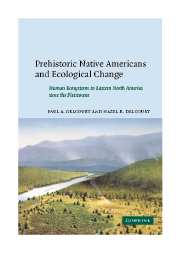 Prehistoric Native Americans and Ecological Change
Prehistoric Native Americans and Ecological Change Book contents
- Frontmatter
- Contents
- Acknowledgements
- PART I PANARCHY AS AN INTEGRATIVE PARADIGM
- PART II ECOLOGICAL FEEDBACKS AND PROCESSES
- 4 Gene-level interactions
- 5 Population-level interactions
- 6 Community-level interactions
- 7 Landscape-level interactions
- 8 Regional-level interactions
- PART III APPLICATION AND SYNTHESIS
- References
- Index
4 - Gene-level interactions
Published online by Cambridge University Press: 30 October 2009
- Frontmatter
- Contents
- Acknowledgements
- PART I PANARCHY AS AN INTEGRATIVE PARADIGM
- PART II ECOLOGICAL FEEDBACKS AND PROCESSES
- 4 Gene-level interactions
- 5 Population-level interactions
- 6 Community-level interactions
- 7 Landscape-level interactions
- 8 Regional-level interactions
- PART III APPLICATION AND SYNTHESIS
- References
- Index
Summary
FROM FORAGING TO CULTIVATION TO PLANT DOMESTICATION
Native Americans have used plants for food, fiber, dyes, medicine, shelter, and fuel throughout their history on the North American continent. The use of plants changed over time as shifts in biotic resources resulted in new possibilities for exploitation of plants. Native Americans were gardeners on a local scale beginning as early as 7800 BP; the development of extensive farming did not take place until about 950 BP with expansion of maize agriculture (Fritz, 1990). The origin of agriculture in the New World involved the interplay of climate change and human–plant mutualistic interactions resulting in genetic selection for productive plant phenotypes.
A continuum of human–plant interactions (Figure 4.1) leads from foraging, through cultivation, to the domestication of plants (Ford, 1979, 1985). Initially, harvesting edible plants may have had minimal genetic impact on the plant populations. Through inadvertent dispersal of seeds and trampling of inedible plant competitors, however, certain food plants may have been encouraged. Later they may have been tended by deliberate weeding out of undesired plants, by dividing and transplanting root clumps, or by sowing of seeds. Cultivation may take the form of tillage, resulting from digging corms, bulbs, tubers, and rhizomes (Anderson, 1997). Cultivation may lead to morphological modification, particularly of fruits and seeds, through deliberate selection and storage, in which case the plant is referred to as domesticated (Ford, 1981; Fritz, 1990).
- Type
- Chapter
- Information
- Prehistoric Native Americans and Ecological ChangeHuman Ecosystems in Eastern North America since the Pleistocene, pp. 36 - 50Publisher: Cambridge University PressPrint publication year: 2004


